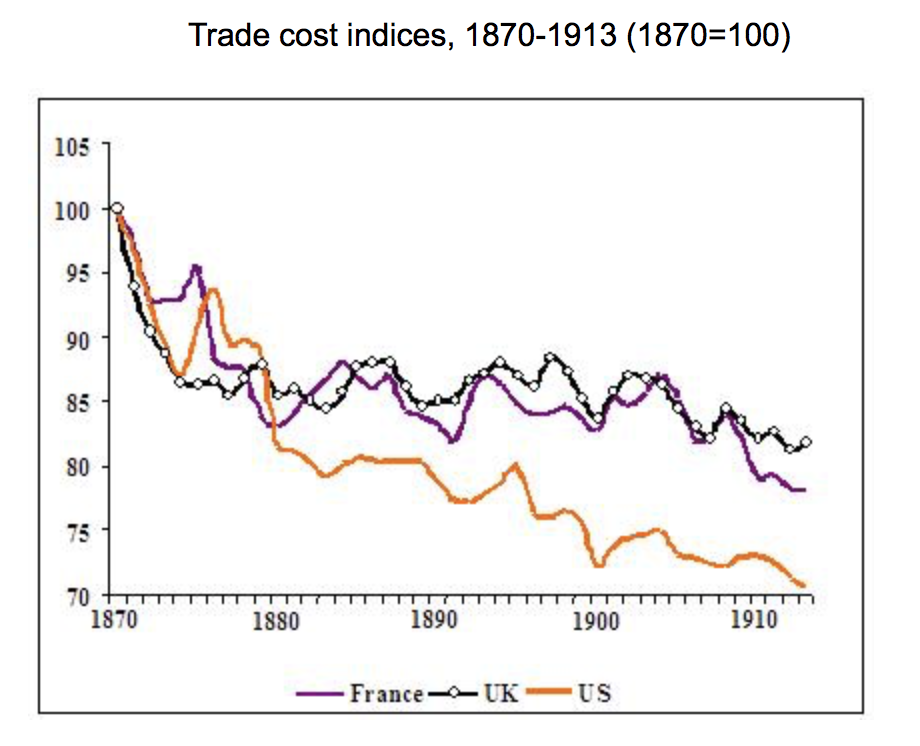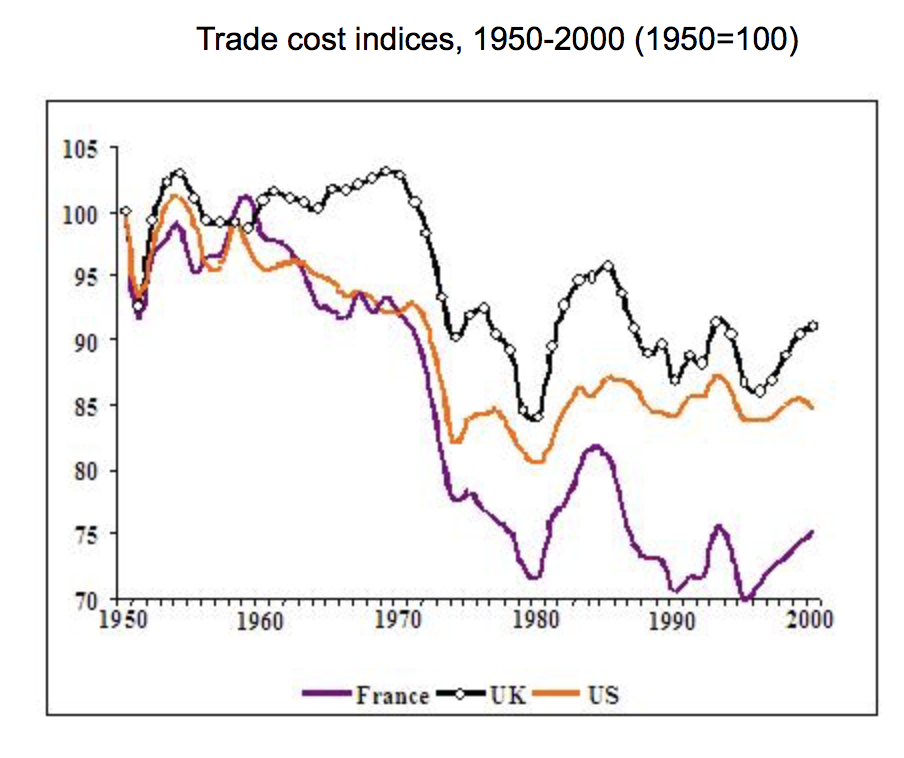Globalization and trade liberalization were supposed to make us all better off through the mechanism of trickle-down economics. What we seemed to be seeing instead was trickle-up economics, accompanied by a destruction of democratic politics, as we moved ever closer to a system of ‘one dollar, one vote’ as opposed to ‘one person, one vote’.
Globalization presumes sustained economic growth. Otherwise, the process loses its economic benefits and political support.
THE RISE OF GLOBAL TRADE
From 1950 to 2004, world trade has grown by close to 6% per annum. Trade tripled compared to output. In the U.S., this resulted in the sum of imports and exports growing from 6% of GDP in 1960 to about 20% at the start of the millennium.
Two factors have been suggested to explain such a rapid and dramatic economic development. First, the cost of transporting goods, let alone services, has dramatically fallen. This was the result of new technologies, such as the development of jet engines and the containerization of shipping, as well as massive infrastructure investment.
The second is the decline of tariffs. With multiple rounds of international negotiation and the creation of institutions like the WTO, tariffs have steadily fallen in the Western world. During the second half of the 20th century, the average U.S. import tariff fell by three-quarters, while worldwide average tariff were more than halved30.
The drop in tariffs – a deliberate policy consciously pursued by governments – has been a more important factor than the decline of transportation costs, a largely technological phenomenon that has occurred outside of governments’ direct control. In 1958, transport expenditures were half the amount of tariffs paid for a typical good. By 2004, the median individual shipment to the U.S. paid 9 times as much for transportation as it incurred in tariffs.
Thus, the surge in trade, while structurally enhanced by constantly improving transport means, has predominantly been the result of a deliberate policy choice of lowering tariff – and non-tariff – barriers. In other words, globalization, as far as trade is concerned, has largely been a policy choice rather than a technology-induced transformation.
This puts the current wave of globalization apart from historical precedents. If one compares the latest round of globalization (1950-2000) to the previous wave (1870-1913), the reasons for it are quite different. Both waves saw trade volume increase markedly31, but in the first round, reduced trading costs are calculated to have accounted for at least 50% of the trade growth. In the second wave, technological gains account for less than a third of the increased trade volume.


TRADE CONSEQUENCES
Trade is positive on a consolidated basis, encouraging specialization and concentration in the most competitive places. But as economic activity becomes displaced across regions and countries, it inevitably creates winners and losers.
Losing areas are forced into lower-value activity or even have their economies “hollowed out” altogether.
When trade deficits are sustained over long periods, the impact on local labor markets and on wealth inequality can be similarly devastating. Observing the impact of trade liberalization between China and the U.S., an NBER research paper concluded: “Alongside the heralded consumer benefits of expanded trade are substantial adjustment costs and distributional consequences. These impacts are most visible in the local labor markets in which the industries exposed to foreign competition are concentrated. Adjustment in local labor markets is remarkably slow, with wages and labor-force participation rates remaining depressed, and unemployment rates remaining elevated, for at least a full decade after the China trade shock commences. Exposed workers experience greater job churn and reduced lifetime income.” The authors found strong correlations across U.S. regions between increased exposure to Chinese imports and lower employment, labor participation, and wages. They estimated that a sustained increase of $1,000 in imports per worker resulted in a $500 reduction in effective annual wages per working age adult and an increase in government benefit spending of over $50 NBER.
The U.S. and China may be better off in aggregate, but some U.S. regions have been pauperized and lower skilled workers particularly affected. European industry may be better off on account of the Euro, but Germany is much better off and Italy somewhat worse off, particularly Italy’s least productive workers.
This generates popular resentment, resulting in politicians opposing the free trade status quo in order to get elected. Assuming the newly elected leaders do not forget their election promises, a trade war can then ensue, for the “losing” region may feel, rationally, that it will be better off with less trade, and start erecting barriers.
The political outcome is exacerbated if the gains derived from the opening of markets are only shared with the weaker “opening” country’s elite. They will be deemed not only to have failed but to be corrupt and incompetent, capitalizing on their fellow citizens’ suffering. The Milanese elite may do well out of Italy’s new specialized trade with Germany, but the young workers receiving minimal wage from squeezed supply chains, and the southern Italians remaining unemployed, will beg to differ and vote accordingly32.
This popular discontent is now reaching a new stage, as illustrated in Italy, by achieving the feat of unifying seemingly irreconcilable right and left political movements. Both the populist left and populist right represent the interests of the losers of European free trade, an alienated class now willing to embrace “protectionist” solutions and openly contemplate the end of the Euro.
The risk is that a trade war spirals out of control, with escalating tit-for-tat tariffs, and all parties end up losing.
COMPROMISE OR LOSE IT
Protectionist measures, while they decrease the global collective optimum, at least temporarily restore local or national fortunes. They will increase economic production, support lower-skilled workers’ wages, and increase inflation. In doing so, they fulfill the mandate given to the populist parties by their voters. But they are far from a panacea. It is easy to see where a trade war starts, but not where it ends, and it could easily slip into a vicious economic downturn. Yet this is where we are inexorably heading if the discontent continues to be ignored. Intereconomics
It is time for globalization’s winners to compromise and attempt to diffuse this political timebomb by agreeing to share part of the gains they’ve made from unfettered free trade. This can be done in many ways, from a specific sales tax on monopolized products from “globalized centers,” temporary tariffs distinctly earmarked for the recycling of some of the trade profits to reinvigorate and redevelop hollowed out regions, and fiscal transfers earmarked for investment and education within a currency union. Sharing is hard to do, and politically difficult to accept. Yet if this is not done, the next economic downturn – and it is approaching – will unleash a wave of political dissent that will put an abrupt stop to globalization as we have come to know it.